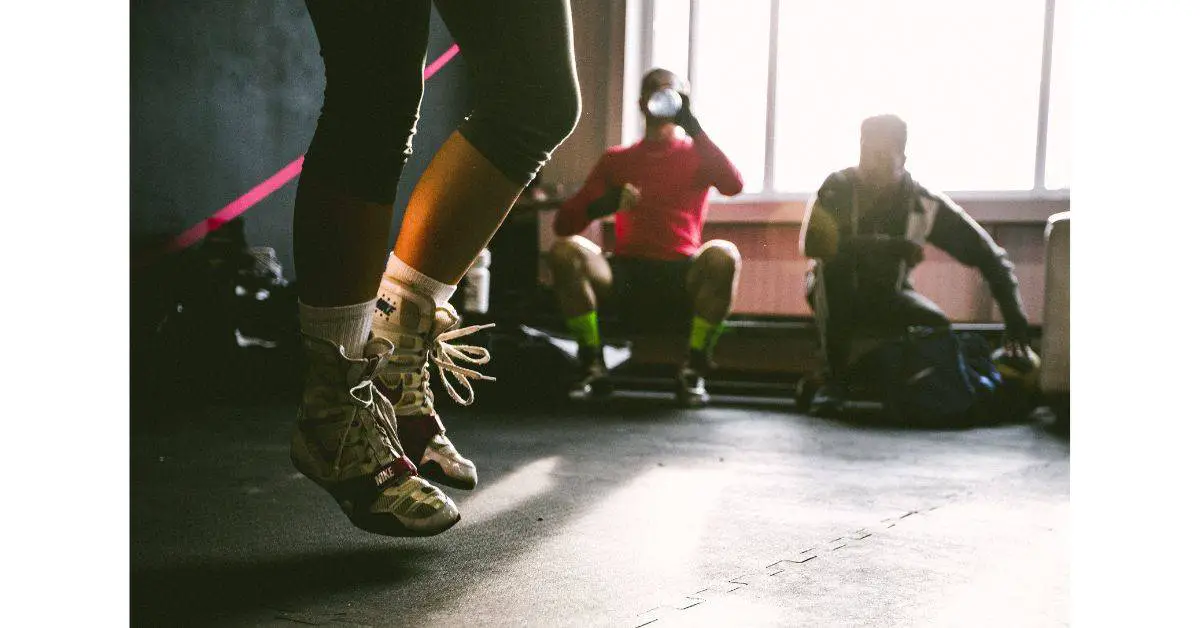Taking punches easily is a fundamental skill all boxers should work on. It’s only common sense you’ll get hit in a sport where the sole purpose of the opponent is to punch you right in the face as many times as possible.
That’s why learning to take these hits and turn them into a not so terrible thing—is vital.
This article will list 11 things you can do while taking a punch to ensure you’re taking the least amount of damage.
It’ll help if your goal will be to avoid these punches in the first place. Nevertheless, sometimes it’s not that simple and a punch in your face is inevitable. Knowing how to react to such a situation will be the difference between losing and winning more boxing fights.
#1 – Try to deflect the punch with your shoulder
The first tip we’ll discuss is deflecting punches with your shoulders. Then, of course, you would have to see the punch coming at you and react appropriately, which sometimes isn’t possible.
However, you’ll be in a much better state for the later rounds if you manage to get hit in the shoulder instead of the ribs or face.
Deflecting with your shoulder is an action most of us naturally possess. It’s a part of our intuition, the same way we contract when we get hit. But you still have to nurture it to make it a habit and not an intuitive move.
The next time you identify a punch you can block with either one of your shoulders, roll to the side, and do just that.
#2 – Control your pain (Don’t freak out)
Freaking out is worse than getting hit. I prefer getting hit 10 times than freaking out over a single one. You must learn to control your pain instead of overly tensing your body because of freaking out over getting hit.
You’ll slowly develop this relaxed part in yourself when you condition your body, especially your abs.
Although we’ll have an entire section dedicated to boxing exercises you can do to ensure you’re dealing with physical pain in a relaxed way; we’ll mention one you can do to avoid freaking out.
Dedicate some time in training to have your boxing partner lightly hit you in the body. Then, slowly pick up the pace while you remain relaxed. You must deliberately relax your body when your partner amps up the power.
Your intuition will be to freak out when you get hit. This is why you must deliberately tell yourself to stay relaxed. Your body will act on autopilot if you don’t.
#3 – Be relaxed
Being relaxed is key to getting hit numerous times. It’s pretty funny how many issues you can solve in life by being relaxed.
Try to be more relaxed in your next spar or fight. For example, don’t hold your breath when you get hit. Instead, exhale sharply and keep moving.
Your body will contract in ways that’ll make the punches you get—more painful if you’re tense. Thus, it’ll be best if you stay relaxed, and everything else will flow naturally.
#4 – Tighten your guard
This tip holds more truth when you’re about to get hit in the face. Did you ever see a boxing match where one of the boxers was on the offense while the other one holding his guard? Sometimes it can be the case for more than 30 seconds!
Tightening your guard can be the difference between getting hit directly in the face and blocking numerous hits.
It can also protect you from body shots if you contract, stay relaxed, and lower your guard to block your abs. You’ll block all the hits if you tense your guard. But, you might get hit numerous times in your face and become dizzy if you loosen or lower your guard altogether.
Before you even think about tightening your guard, you must perfect it. So make sure to work on your guard and perfect it before you use this tip. Here’s how you get a perfect guard position:
The primary guideline you should follow is to tuck your elbows while resting your hands at your cheek or eye level. You’ll be more likely to block all hits to the face and take punches easily if you perfect your guarding position while tightening it whenever required.
#5 – Tense your abs
This section will examine the classiest method you can implement to take a punch easily: tensing your abs. You can tense your abs in two primary ways:
You can either focus on contracting your abdominal muscles or you can exhale sharply (making a “tss” sound.) The second method (exhaling) is superior to the first one since it won’t require you to invest that much mental effort to remember to do it.
I recommend making exhaling a habit when you get hit or throw a punch, since it’s a much easier method to remember. You don’t need to focus on contracting your abs, as it requires more mental effort.
Likewise, it’s much more effective to exhale instead of contracting your muscles. Contracting your muscles will require you to invest more effort and will tire you more quickly than exhaling only when you need to.
#6 – Keep your chin down
Sometimes, you’ll need to accept the fact that you are about to get hit right in the face. I won’t go over the reasons why you got punched in the face in this article.
However, let’s assume there’s a 100% chance you’re going to get hit. What’s the one reaction you should have? That’ll be to keep your chin down and soak the hit with your forehead.
Keeping your chin down while tightening your guard and letting your forehead soak the hit—will lead to the least amount of damage to your head.
You can even keep your chin down if you’re not about to get hit, but are just preparing for the worst case scenario.
If you want to win more boxing fights faster, follow the link to read practical ways you can implement today to ensure you do just that.
#7 – Exhale and don’t hold your breath
I wrote an entire article on correct breathing in boxing; I recommend reading it if you want to boost your boxing skills with an underrated skill: breathing.
Exhaling is critical for dealing with punches. You’ll find the punch more painful if you hold your breath or inhale when you get hit.
You also need to exhale when you throw a punch or a combination of punches. This will help you punch harder without having to invest a lot of physical effort.
Correct breathing is vital in boxing.
Try to exhale sharply right now. You see how your core tenses? Try to make a quick “tss” sound. You’ll notice how your abs contract instantly, which we discussed in tip #5.
Make exhaling sharply a habit. You’ll notice how your punches are more powerful while making you deal with physical pain better.
#8 – Roll with the punch
Rolling with the punch isn’t something you really practice but something which will come with time and experience. It’ll come naturally for most boxers who get hit in the face enough times.
Probably the most popular tip to deal with punches easily is to roll with the punch. So, what does that even mean?
Rolling with the punch means going in the motion of the punch after you got hit. If you get hit in the head toward the left side, roll your head to the left after you got hit. The same applies to the right side and even upwards.
This perhaps is the one way every boxing coach will tell you to do. It makes a lot of sense once you think about it; there’ll be more damage to your face if you resist the punch, creating more resistance and thus more force.
As a result, it’ll be best if you keep the motion of the punch after you got hit. Hopefully, however, you won’t have to get there in the first place.
If you want to learn how to fight but are hesitant because of the high injury rate, here are boxing alternatives you can do to learn how to fight but without the high injury rate.
#9 – Perform exercises to condition your abs
While training your abs or core won’t make you feel less pain, it’ll help you condition your body. I’m not saying to do 100 sit-ups daily, but to practice specifically for boxing to keep fighting after you got hit.
A few exercises will help you achieve that. I’ll mention two I specifically like in this section. That said, anything that involves you getting hit in the body in training will do.
The first exercise is to have a friend punch your body. Start slowly and with low force. Then, slowly progress into more fierce shots. You should exhale after every punch. Try to remain loose and not tense your body. You should be able to talk and whisper if you want.

Another exercise is to hang on a pull-up bar and have your friend punch you. That removes your foot support and allows you to get used to the pain.
The second exercise is perfect for dealing with physical pain. This can be critical for those who feel like they can’t get hit without wanting to stop the fight.
#10 – Don’t stop fighting after getting hit
Your intuition will be to stop fighting after getting hit. However, you want to avoid this natural action by returning to your fighting mode immediately.
A good way many boxers use is having a word or a particular phrase you tell yourself when you feel like stopping the fight. It can be as simple as “fight” or “go, go, go!”
Notice how you want to stop the fight once you feel physical pain, especially in training. Now you can force yourself to keep fighting; returning to your fighting mode will slowly become a habit, so don’t give up and keep practicing.
#11 – You’ll take the punch better if you see it
The last tip is to predict and see the opponent’s punch. You’ll develop a sixth sense of seeing punches coming – with time and experience. However, it’ll require you to keep boxing, especially when you don’t want to get up in the morning to train.
You’ll react to the punch better if you see it coming. Imagine how painful and surprising a left hook to the face will be if you don’t see it. Trust me; it can be a pain you will never forget.
That’s why it’ll be best to identify as many punches as possible before they hit you. Then, your body will naturally react to them by activating all its defensive intuitions to counter as much pain as possible. Your body is an intelligent machine, after all.
Final words
If you want to take punches easily, implementing the methods I presented in this article is the next thing for you.
Try to work on a single method one at a time. Your brain will get overwhelmed quickly if you take on too many tasks at a time. That’s why working on a single thing every time will help you develop habits more quickly and effectively.
You’ll also enjoy reading about ways to box without a punching bag if you enjoyed reading this article; do give it a read to learn how.

